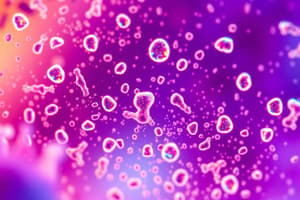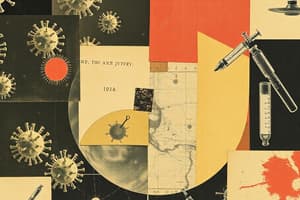Podcast
Questions and Answers
Who proposed the 'germ theory' that disease spreads from person to person via invisible viruses?
Who proposed the 'germ theory' that disease spreads from person to person via invisible viruses?
- Girolamo Francastoro (correct)
- Ignaz Semmelweis
- Antonie van Leeuwenhoek
- Francesco Redi
What did Robert Koch emphasize in microbiology research?
What did Robert Koch emphasize in microbiology research?
Isolation, culture, and characterization of microorganisms causing important diseases in man.
Joseph Lister advocated the use of phenol as a disinfectant in 1860.
Joseph Lister advocated the use of phenol as a disinfectant in 1860.
True (A)
The cell wall of most bacteria consists of a type of peptidoglycan called ____, which is essential for protection.
The cell wall of most bacteria consists of a type of peptidoglycan called ____, which is essential for protection.
Match the following terms with their correct descriptions:
Match the following terms with their correct descriptions:
What is the main function of the periplasmic space?
What is the main function of the periplasmic space?
Which of the following is a function of the cytoplasmic membrane?
Which of the following is a function of the cytoplasmic membrane?
What is the primary component of the cytoplasm?
What is the primary component of the cytoplasm?
What is the function of flagella in bacteria?
What is the function of flagella in bacteria?
What is the outermost layer of the gram-negative bacterial cell wall?
What is the outermost layer of the gram-negative bacterial cell wall?
What is the function of the outer membrane proteins?
What is the function of the outer membrane proteins?
What is the purpose of the periplasmic space?
What is the purpose of the periplasmic space?
What is the function of the cytoplasm in a bacterial cell?
What is the function of the cytoplasm in a bacterial cell?
What is the main component of the cytoplasmic membrane?
What is the main component of the cytoplasmic membrane?
Which of the following is NOT a function of the outer membrane?
Which of the following is NOT a function of the outer membrane?
Flashcards are hidden until you start studying
Study Notes
History of Microbiology
- Girolamo Fracastoro (1483-1553) proposed the "germ theory" of disease, stating that diseases spread from person to person via invisible viruses.
- Antonie Van Leeuwenhoek (1632-1723) developed simple microscopes, magnifying 50-300x, and described bacteria and protozoa in dirty water.
- Francesco Redi (Italian doctor, 1665) demonstrated that "worms" in rotting meat are fly larvae.
- Ignaz Semmelweisz (Hungarian gynaecologist, 1865) recommended handwashing and adding slaked lime to water to prevent the spread of disease.
Louis Pasteur and Robert Koch
- Louis Pasteur (French chemist, 1822-1895) studied yeasts that convert grape juice into wine, leading to the discovery of pasteurization (wet heat under 100°C).
- Pasteur developed vaccines against anthrax and rabies, laying the foundation for immunology and biochemical/industrial microbiology.
- Robert Koch (German researcher, 1843-1910) emphasized the importance of isolating, culturing, and characterizing microorganisms that cause diseases in humans.
- Koch's postulates must be met to establish the relationship between a microorganism and a specific disease: • The microorganism must be present in every case of the disease. • The microorganism must be isolated from the diseased host and grown in pure culture. • The specific disease must be reproduced when a pure culture of the microorganism is inoculated into a healthy but susceptible host. • The microorganism must be re-isolated from the host that was experimentally infected.
Other Important Discoveries
- Joseph Lister (Scottish surgeon) advocated for the use of phenol as a disinfectant in 1860, leading to the modern era of aseptic surgery.
- Elie Metchnikoff (Russian zoologist) worked at the Pasteur Institute and was awarded the Nobel Prize in 1908 for his work on cellular immunity.
- Selman Waksman discovered streptomycin in 1944, leading to the era of antibiotics.
- Max Theiler developed a vaccine against yellow fever in 1950 using an attenuation technique.
- Jonas Salk developed a vaccine against polio in 1951.
The Greatest Biological Discovery Ever
- James Watson and Francis Crick (Nobel Prize winners, 1959) elucidated the mechanism of DNA replication, gene function, and cell division.
Taxonomy
- Taxonomy is the science of biological classification, involving the arrangement of organisms according to specific laws.
- Classification involves arranging organisms into groups based on similarities, such as size, structure, and method of reproduction.
- The most general sequence of classification is: Species, Genus, Family, Order, Class, Phyla or Divisions, and Kingdom.
- Microbiologists use the binomial system to name microorganisms, consisting of a genus and species.
Morphology of Bacteria
- Bacteria come in various shapes and arrangements, including coccus (sphere), bacillus (cylinder/rod), spiral shaped spirillum (rigid), and spirochaete (flexible).
Bacterial Structure
- The cell wall of bacteria is essential for protecting the protoplast from osmotic lysis and is composed of peptidoglycan.
- Gram-positive bacteria have a thick peptidoglycan layer, while Gram-negative bacteria have a thin layer of peptidoglycan surrounded by an outer membrane.
- The outer membrane contains lipopolysaccharide (LPS or endotoxin), which is toxic to animals.
Cell Wall and Membranes
- The cell wall is essential for bacterial viability and is a target for antibiotic treatment.
- The Gram staining procedure distinguishes between Gram-positive and Gram-negative bacteria.
- Gram-positive bacteria have a thick peptidoglycan layer, while Gram-negative bacteria have a thin layer of peptidoglycan surrounded by an outer membrane.
- The outer membrane contains proteins and lipopolysaccharide (LPS or endotoxin).
Cytoplasm and Periplasmic Space
- The cytoplasm is the portion of the cell that lies within the cytoplasmic membrane.
- The cytoplasm contains proteins, vitamins, ions, nucleic acids, and other cellular constituents.
- The periplasmic space is the area between the peptidoglycan and the outer membrane, containing hydrolytic enzymes, binding proteins, and chemoreceptors.
Flagella, Fimbriae, and Pili
- Flagella are organs of motility, allowing bacteria to move to areas with favorable conditions.
- Fimbriae and pili are fine hairlike projections from the cell envelope, found in many Gram-negative bacteria.
- Fimbriae are involved in attachment and are important virulence factors.
- Pili are involved in the transfer of genetic material between bacteria during conjugation.
Capsule and Biofilms
- A capsule is a discrete layer of polysaccharides deposited outside the cell wall, protecting bacteria from phagocytosis and desiccation.
- Biofilms are multilayer bacterial populations embedded in a polysaccharide matrix, attached to a surface, and can act as a source of infection.
Endospores
- Endospores are produced within cells and are resistant to heat, radiation, chemicals, and desiccation.
- Endospores are characteristic of organisms that live in soil and need to withstand adverse conditions.
- Bacillus and Clostridium are spore producers, and their spores can survive for a long time and then re-germinate.
Bacterial Structures
- Flagella: made from globular protein (flagellin) to form a hollow cylindrical structure, allowing bacteria to move to areas with favorable conditions through random movement.
- Flagella also act as a virulence factor for some organisms, transporting them to attachment sites for colonization.
Fimbriae and Pili
- Fimbriae: fine hair-like projections from the cell envelope, found in many Gram-negative bacteria, shorter and finer than flagella.
- Fimbriae: also called common pili, important virulence factor, acting as adhesins for attachment, essential for pathogenesis.
- Pili: also referred to as sex pili, few per cell, mediate transfer of genetic material between bacteria during conjugation.
Capsule
- Capsule: a discrete, detectable layer of polysaccharides deposited outside the cell wall, exhibiting marked serological specificity in many bacteria.
- Functions: protects bacterial cells from engulfment by protozoa or white blood cells, protects against drying or desiccation, reserves carbohydrates for subsequent metabolism, mediates adherence to surfaces.
Biofilms
- Biofilms: multilayer bacterial populations embedded in a polysaccharide matrix, attached to a surface, acting as a source of organisms.
- Functions: play a role in formation of plaque, cause colonization of plastic catheters and implants, protect bacteria against phagocytes, inhibit penetration of antibodies and antimicrobial drugs, resistant to disinfections.
Endospores
- Endospores: produced within cells, cell wall consists of a polymer of disaccharides cross-linked by short chains of amino acids (peptides), a type of peptidoglycan called murein.
- Functions: essential structure for viability, important target for antibiotic treatment, important adherence and receptor sites, can cause symptoms of disease, provide immunological distinction and variability between bacterial strains.
Gram-Positive and Gram-Negative Cell Walls
- Gram-positive cell wall: thick layer of peptidoglycan, stains purple with crystal violet dye during Gram-staining.
- Gram-negative cell wall: thin layer of peptidoglycan, surrounded by a membranous structure called the outer membrane, stains red, contains lipopolysaccharide (LPS or endotoxin), which is toxic to animals.
Gram-Positive Cell Wall
- Thick peptidoglycan layer, traversed by teichoic acids, plus carbohydrates and proteins depending on the species.
Gram-Negative Cell Wall
- Two separate areas with an additional membrane: periplasmic space, thin layer of peptidoglycan, and outer membrane.
Outer Membrane Proteins
- Outer membrane proteins: contribute a significant portion of the outer membrane, with major outer membrane proteins (OMPs) present in the greatest amount.
- Porins or matrix proteins: form channels in the outer membrane, allowing passive transport of aqueous materials into the periplasm.
Functions of the Outer Membrane
- Confers negative charge to the bacterial cell.
- Selective barrier, with pores for entrance of hydrophilic molecules (antibiotics).
- Phage receptors.
- Pathogenic properties.
- Stabilizes mating cells and keeps enzymes in the periplasm.
Periplasmic Space and Cytoplasmic (Cell) Membrane
- Periplasmic space: area between the peptidoglycan and the outer membrane, contains hydrolytic enzymes, binding proteins, chemoreceptors, and detoxifying enzymes.
- Cytoplasmic membrane: composed of a hydrophobic phospholipid bilayer and proteins, retains the cytoplasm, acts as a selective barrier, and facilitates transport.
Cytoplasm
- Cytoplasm: portion of the cell that lies within the cytoplasmic membrane, contains proteins, vitamins, ions, nucleic acids, amino acids, sugars, carbohydrates, and fatty acids.
- Functions: holds many cellular constituents, within the cytoplasm that many of the functions for cell growth, metabolism, and replication are carried out.
Studying That Suits You
Use AI to generate personalized quizzes and flashcards to suit your learning preferences.




